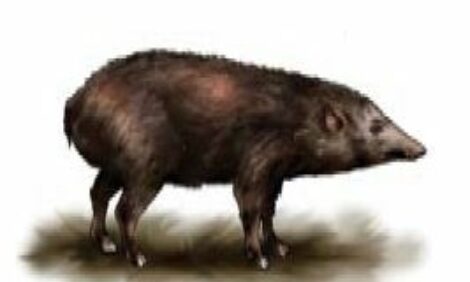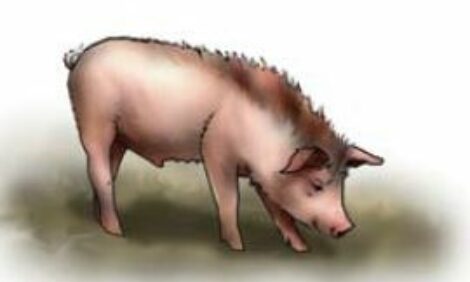



Black Slavonian
The Black Slavonian Pig breed appeared during the 19th century, bred on the estate of Count Karl Pfeiffer near Osijek. This breed arose from the Lasasta Magnolica, Cornwall Black, and Poland China breed, and were bred due a need for a breed of pig which grew quickly, efficiently, and would be comfortable living in the large pastures of the area. The Black Slavonian Pig breed was recognized in 1873 at an exhibition in Vienna and were popular through the 1800s but decreased in popularity as factory farming grew, as they required that pasture in order to grow properly. In 1996, Croatia signed a Biodiversity Treaty, including the Black Slavonian Pig as one of its breeds to be preserved. This led to the breed’s numbers increasing to over 1000 by2012. The current breeding population originates from a limited gene pool of 46 sows and 6 boars identified in 1996.
Its namesake black coat is its dominant trait, along with distinctive semi-lop ears. The Black Slavonian has more intramuscular fat than other breeds of pigs but, smaller outer layers of fat. This type of meat is considered ideal for production of sausage, bacon, and a local product called 'Kulen', a local dry sausage. Black Slavonian are typically fattened up for eighteen months before being slaughtered; at that age, they weigh between 285 and 330 lbs (130 to 150 kg).
The Black Slavonian Pig has a greater life expectancy and better environmental adaptability than the standard factory farmed pig; they are adapted to outdoor farming systems with open foraging for food. Black Slavonian pigs thrive best on a mixture of green forage like field peas, grain, and legumes, as well as specialised feed. The Black Slavonian Pig can reach 330 lbs (150 kg) of weight at 20 months of age if the wild diet is supplemented. Without supplementation, one hectare of land can support up to four breeding sows and their piglets. It has improved disease resistance when compared to many domesticated swine breeds, due to its rugged nature. The Black Slavonian Pig produce six to eight piglets per litter, two to three times a year, with piglets staying with the mother for up to seven weeks before being weaned. The fertility of the Black Slavonian Pig breed is generally considered to be low due to its limited gene pool, but there are programmes in place to change this. Black Slavonian pigs are being crossbred with Great White and Swedish Landrace breeds to increase genetic vigour and quality of meat. There is also discussion of introducing English Large Black Boars to add genetic variety without losing the Black Slavonian Pig genetic distinctiveness, since the English boars were a contributing source of the original genetic stock.








